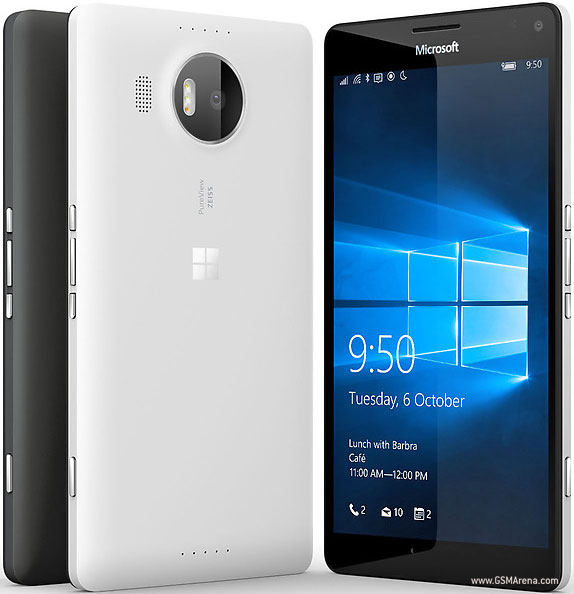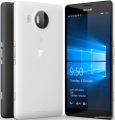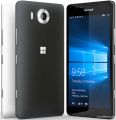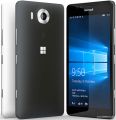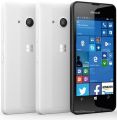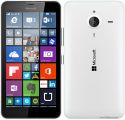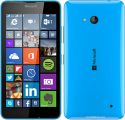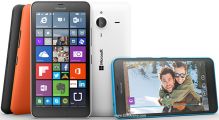Microsoft Lumia 950 XL Prices
Important Note.
- All prices are in Pakistani Rupee (PKR)
- Prices may vary at stores and our effort will be to provide you with the updated prices.
- The latest price of Microsoft Lumia 950 XL was obtained on 17 مئی, 2019. The prices at the original stores had been updated on the respective mentioned dates.
- Find out WhatMobile price has dropped in Pakistan by selecting Notify Price Drop button
- Find out WhatMobile has better specifications by clicking Add To Compare Button find out what Mobile has better reviews by visiting our reviews section
- Find out WhatMobile is cheaper on which retailer by clicking Compare prices from retailers button
Search Terms
- Microsoft Lumia 950 XL
Specifications
| GENERAL | |
| 2G Network | GSM 850 / 900 / 1800 / 1900 |
|---|---|
| 3G Network | HSDPA 850 / 900 / 1700(AWS) / 1900 / 2100 |
| 4G Network | LTE band 1(2100), 2(1900), 3(1800), 4(1700/2100), 5(850), 7(2600), 8(900), 12(700), 20(800), 28(700), 38(2600), 40(2300) |
| Sim | Nano-SIM |
| Announced | 10/10/2015 |
| Status | Available. Released 2015, November |
| BODY | |
| Dimensions | 151.9 x 78.4 x 8.1 mm (5.98 x 3.09 x 0.32 in) |
| Weight | 165 g (5.82 oz) |
| DISPLAY | |
| Display Size | 5.7 inches, 88.5 cm2 (~74.3% screen-to-body ratio) |
| Resolution | 1440 x 2560 pixels, 16:9 ratio (~518 ppi density) |
| MultiTouch | Yes |
| Protection | Corning Gorilla Glass 4 - ClearBlack display |
| SOUND | |
| AlertTypes | Vibration; MP3, WAV ringtones |
| LoudSpeaker | Yes |
| 3.5mm jack | Yes - Active noise cancellation with dedicated mic |
| MEMORY | |
| CardSlot | microSD, up to 256 GB (dedicated slot) |
| Internal | 32 GB, 3 GB RAM |
| DATA | |
| GPRS | Yes |
| EDGE | Yes |
| Speed | HSPA 42.2/5.76 Mbps, LTE Cat6 300/50 Mbps |
| WLAN | Wi-Fi 802.11 a/b/g/n/ac, dual-band, hotspot |
| Blue Tooth | 4.1, A2DP |
| NFC | Yes |
| USB | 3.1, Type-C 1.0 reversible connector |
| CAMERA | |
| Camera Primary | 20 MP (f/1.9, 26mm, 1/2.4", 1.12 µm), Carl Zeiss optics, OIS, autofocus, triple-LED RGB flash |
| Camera Features | Geo-tagging, face detection, panorama, HDR, PureView |
| CameraVideo | 2160p@30fps, stereo sound rec., 1080p@30/60fps (after SW update) |
| CameraSecondary | 5 MP, f/2.4, 1080p |
| FEATURES | |
| Processor Cores | Octa-Core |
| OS | Microsoft Windows 10 |
| CPU | Octa-core (4x1.5 GHz Cortex-A53 & 4x2.0 GHz Cortex-A57) |
| Sensors | Iris scanner, accelerometer, gyro, proximity, compass, barometer, sensor core |
| Messaging | SMS (threaded view), MMS, Email, Push Email, IM |
| Browser | HTML5 |
| Radio | FM radio |
| GPS | Yes, with A-GPS, GLONASS, BDS |
| Colors | Black, White |
| Others | - Microsoft Continuum support - Qi wireless charging (market dependent) - Fast charging - MP3/WAV/eAAC+ player - MP4/H.265 player - OneDrive (15 GB cloud storage) - Document viewer - Video/photo editor |
| BATTERY | |
| Battery | Removable Li-Ion 3340 mAh battery |
| StandBy | Up to 288 h (2G) / Up to 288 h (3G) |
| TalkTime | Up to 25 h (2G) / Up to 19 h (3G) |
| MISC | |
Reviews
Introduction, design and display
Lumia flagships are a rare breed, not just in terms of new models, but on the street as well. Almost four years have passed since the Lumia 900 line began, and a lot has happened in that time – not least the evaporation of Windows Phone's already paltry market share.
The Nokia Lumia 930, nominally the last flagship-class device in the WIndows Phone era, was released back in mid 2014, but the world has moved on.
Now, a QHD screen and a powerful 64-bit processor is the bare minimum that an elite-tier handset needs in order to compete. And with quality imaging also becoming the norm rather than the exception, there's little room for compromise at the top.
Against this, everything that once made the Lumia brand special no longer has such lustre. Optical imaging stabilisation is one such example – the thing that Nokia once did best is now commonplace.
Dreams of making smartphones for everyone and seeing Windows 10 Mobile conquer the world with coloured tiles have been replaced with a more modest ambition: making devices to reward fans who stuck with the OS through the lean times.
Enter the Microsoft Lumia 950 XL, alongside the Lumia 950.
The Lumia 950 XL is, as the name suggests, the larger device of the two, and it boasts some hefty specifications too, meaning that on paper it looks to be a smartphone geek's dream.
But with the Android and iOS competition now so incredibly strong, is it really enough to restore consumer confidence in Microsoft's mobile vision?
Design
Over its years as a smartphone maker Nokia built up a considerable design pedigree, and the Lumia line was no exception. With the handsets defined by the use of colourful matte polycarbonate, even a punter on the street could recognise the likes of a Lumia 920 at a distance.
Things have changed under the bean counters at Microsoft, and at first glance the Lumia 950 XL is almost totally unremarkable, at least from the front. The 5.7-inch AMOLED display, covered with a sheet of Gorilla Glass 4, takes up most of the faceplate, with only a small, minimalist 'Microsoft' logo adorning the top.
The rear of the handset also tends towards a corporate look and feel. A vast expanse of featureless black matte polycarbonate houses just two notable landmarks – a large, silver-ringed camera 'oreo', and a small Windows logo.
The power button and volume keys are on the right side, as you'd expect, but their layout is odd and confusing. Whereas the power button normally stands alone, on the Lumia 950 XL it's flanked by separate volume up and volume down keys.
This may sound like a minor detail, but as someone who's used Lumias on a daily basis for years I found the new button layout jarring throughout my review period. Moreover the buttons themselves, while nicely clicky, are quite sharp, making them feel unfinished.
On the same side you'll also find the two-stage camera shutter button, always a nice inclusion.
Thankfully, one trend that began a while back – the abandoning of removable backs – has been reversed here. The rear of the Lumia 950 XL is user-removable and replaceable, giving access to the microSD card slot and to the removable battery.
As the 950 XL is a phablet, using it in one hand was always going to be something of a challenge, but thanks to the weighting of the device it's not as bad as I feared it might be. Even at 8.1mm thick and 165g, and with my spindly little mitts, using the handset was never uncomfortable.
Overall, the design of the Lumia 950 XL is unremarkable. In a budget smartphone, I'd list that as a positive, especially given some of the weird-looking units that are occasionally trundled out; but in a 2015 flagship device that costs the best part of an iPhone, it's a different story.
When you're spending the sort of money on a handset that could buy you a week's holiday for two, the experience has to reflect that, and that experience starts when you first pick up the device.
Buy an iPhone 6S and the jewel-like feel is an instant reward, and the same goes for the Samsung Galaxy S6 or even the Google Nexus 6P. These devices are distinguishable and special, whereas the Lumia 950 XL is unfortunately reminiscent of its less-upmarket brother, the 640 XL.
Earlier Lumia devices gave the user a sense of identity in the hand, something unique, and that has been lost. Whether the diehard Windows faithful will care has yet to be seen, but other potential purchasers are unlikely to be blown away.
The genesis of a new operating system that prioritises a unique and cohesive design should be honoured in the hardware carrying it, such as with the Dell XPS 13, and in this respect Microsoft has failed with the Lumia 950 XL.
Display
The screen is another story altogether, and clear signs of Nokia's display heritage can be found in the Microsoft Lumia 950 XL. Outdoor visibility is pretty good, although it would be nice if the screen could become just a tad brighter. The 2K resolution of the 5.7-inch panel equates to a 518ppi, making text lovely and crisp, and enabling the Windows Live Tiles to really stand out.
As might be expected with an AMOLED screen, contrast is excellent. Colours have a very nice 'pop' to them, while blacks are pleasingly deep. Viewing angles are great, with no drop-off in either brightness or colour from any angle.
Somewhat unusually for an AMOLED display, the colour accuracy is also very good. Microsoft claims to have calibrated the panel exactly, and to my eyes I could find nothing wrong, although you have the option to change the white balance in the settings menu.
The device also supports a popular and somewhat mislaid feature in 'Glance', which enables the display of information when the phone is asleep. Double-tap to wake has been discarded, however.
Key features
A lot has been said about Microsoft's mobile journey. The firm arrived on the scene in 2000 with Windows Mobile, and rebooted with Windows Phone 7 in 2010 and later again with Windows Phone 8; each attempt failed to capture the attention of mainstream users. Windows 10 Mobile is something different altogether though.
The real story behind Windows 10 is the change in focus, a recalibration of Redmond's mobile strategy. In the past we saw the typical Microsoft bravado, bolstered by years at the top of the heap, culminating in rather brash efforts that failed to make a lasting impression.

Windows 10 Mobile is an acceptance of the current reality of the wider smartphone landscape, and of Microsoft's place in it. Microsoft has reinvented its software once more to meet the needs of a different user base, one that values customisation over almost all else and that doesn't care a great deal about looks.
As such, there is plenty of wholesome geekery on offer. Perhaps the best example of this is Windows 'Hello', the iris-recognition technology built into the device.
Theoretically this enables the user to unlock the phone with their eye, but in practice I found that it failed more often than not, no doubt because I wear glasses.

Microsoft has been careful to label the feature as a beta, with shortcomings to be addressed via software updates, and I found that when someone who doesn't wear glasses used the feature the accuracy was much improved.
While iris scanning isn't perhaps as immediately convenient as a fingerprint scanner, it's nonetheless an imaginative inclusion.
As for the wider feel of Windows 10 Mobile, imaginative isn't the first word that springs to mind. When I first used Windows Phone it was on version 7.5, and compared to Android and iOS I generally felt that it had a bold style and cohesion, even in the third-party applications the other systems often lacked.
Windows 8 cemented this, and to this point I don't believe any operating system looks better on an AMOLED screen. With Windows 10 Mobile, however, Microsoft has abandoned this sense of style in favour of feature creep.
This makes for some odd choices. The circles in the revamped People hub are a little grating, while the renamed 'Microsoft Edge' (replacing the inbuilt Internet Explorer) takes a little getting used to. Removing the native Music app for 'Groove Music' is also a little confusing, especially for those unacquainted with Microsoft's new streaming service.
For every downside there is an upside however. Double-tapping the softkey bar causes the display to sleep, while the phone app has a built-in option for voice recording, a godsend for those doing interviews.
There's even a slider for adjusting the transparency of the Live Tiles, which is a nice touch. In short, even more than Cyanogen OS, Windows 10 Mobile has the potential to be something of a tinkerer's paradise.
The story as a whole is of a shift from design over usability to function over form. The experience is still somewhat suspect, though. I suffered regular stutters when using the Start button, frozen screens at random intervals, apps randomly crashing and occasional issues with voice calls, among other things.
Given that Windows Phone as it currently stands is completely rock-solid, the fact that Windows 10 Mobile is such a mish-mash is a little surprising.
Microsoft will in no doubt improve the experience over the next few months, and those with prior experience of using a device with beta software will understand the risks involved; for the average punter, however, it could well be a no-no, at least for the moment.
USB-C
In the last few years microUSB as a standard has become pretty much ubiquitous on smartphones, with almost every device (so long as it doesn't bear the Apple logo) using such a port for charging and data transfer. The times, however, are a-changing.
USB-C offers a couple of advantages over microUSB, enabling faster charging and, by incorporating a reversible connector design, eliminating the problem of trying to plug the cable in the wrong way up.
This is all well and good, but there's just one problem: good luck trying to find someone who has a spare USB-C cable handy.
With only a few flagship phones currently using the standard, we're not throwing away our microUSB cables just yet. I've been through around four phones in the last five years or so, and I've accumulated roughly enough microUSB cables to circle the Earth twice.
This means that charging most devices isn't an issue, and neither are lost or damaged cables. Working with USB-C is another matter altogether.
Moreover, with the Lumia line, the 'wrong way up' problem was solved with the addition of a textured pattern on the charging cables supplied by Nokia – that one small indent made a big difference.
On the Lumia 950 XL I found the USB-C port more of an irritant than anything else, and if the point of the change from microUSB is convenience, then I'm missing something. I had to remember to take a USB-C cable with me for data transfer and charging in different rooms, something which was a definite nuisance.
This could prove to be a real pain when travelling as well – you can pick up a generic microUSB charger simply and cheaply just about anywhere, and that's far from the case with USB-C at the moment.
Although devices such as the OnePlus 2, Nexus 5X, Nexus 6P and LG G5 have adopted the standard, it's not being taken up beyond by everyone with the Samsung Galaxy S7 and S7 Edge sticking with microUSB.
One Great Continuum
Despite the ever increasing power of smartphones giving developers more and more options for expansion and improvement, not much has actually changed in the last few years. Case in point with the iPhone, which despite various iterations since its original release is still functionally the same device.

With the Windows 10 unified code base and variable design language, Microsoft is hoping to position Continuum as a halfway point between the mobile phone and the desktop, as a device that can revolutionise computing as a whole.
At the moment however, Continuum is limited to dedicated Windows apps, of which there are only a few, meaning the feature is effectively a mirror of Windows RT, enabling a little extra functionality when plugged into a bigger screen.
If the story of Windows 10 is one of potential however, then Continuum is easily the feature that has the greatest chance to become something great; however only time will tell what will become of Microsoft's admirable effort.
Specs and performance
If there was one advantage in waiting so long before bringing out the next elite Lumias, it was that Microsoft had the chance to thoroughly analyse hardware trends before jumping in. As such, the Microsoft Lumia 950 XL comes well equipped, both by the standards set for 2015 and for the future.
Powering the device is the controversial Qualcomm Snapdragon 810, an octa-core 64-bit chip clocked at 2.0GHz, and backed up with 3GB of RAM. Much has been written about the Snapdragon 810, and the various '-gates' it's caused, in the past year.
Microsoft has worked hard to counter reported overheating and other issues. The chip is a newer version from Qualcomm, lacking some of the problems of its predecessor, but perhaps more importantly, the Lumia 950 XL has liquid cooling. That's right: liquid cooling.

The geek cred of such a feature notwithstanding, in general use I still found that the device could become quite warm, especially when attempting to do several things at once, or when experiencing one of Windows 10 Mobile's frequent bug episodes.
This also raises concerns regarding the longevity of the device. There's no doubt that Microsoft will continue to optimise both the OS and the chip so they can run with some increased degree of harmony, but whether the phone might melt internally beforehand is another question altogether.
Despite this, whether gaming or running multiple apps at once, I experienced no slowdowns. Really, there's nothing in the Windows Phone app ecosystem that can really challenge the likes of the 810, especially given that the previous most powerful chip in widespread use was 2013's Snapdragon 800, in the likes of the Lumia 1520 and 930.
The app problem on Windows 10 Mobile is the same as it was on Windows Phone – that's to say, pretty bad. Geekbench 3 was not available for use, and so Basemark OS 2 was used. For comparison, I also ran the benchmark app on both the Nokia Lumia 930 and the Microsoft Lumia 950.
All results ought to be taken with a pinch of salt. Windows Phone has many great third-party solutions to many aspects of the app gap, but a proper, current benchmarking app has yet to arise.
Overall the results were a little odd, with the Lumia 930 achieving an overall score of 1001, the 950 managing 1295 and the XL managing only a paltry 890. This doesn't show the whole story however, with the graphics section being quite telling.
Here the 930 managed 1212, the 950 came to 1436 and the XL bounding ahead to 2014. In the System and Web sections, the XL achieved a considerable lead also. However, this was only due to a odd problem with the memory segment, seemingly due to the device attempting to write to microSD rather than the faster flash system memory.

With regards to memory management, Windows 10 Mobile takes a cue from iOS. Instead of truly running in the background, apps are paused, with only certain trusted sources able to break this lock.
This means that multi-taskers might be slightly frustrated, but it makes for swift transitions between apps, as well as meaning that wayward processes have less of a chance to malfunction and consume battery. The device can handle around eight open apps at once before beginning to close processes.
In everyday use I found the Lumia 950 XL to be a strong performer. When swiping through the OS, and opening and closing apps, everything worked as it should. However, as is something of a trademark with Windows Phone, there wasn't much separating it from my Lumia 930 in terms of performance.
The spec sheet of the XL may be an indication of where things are heading, but for the moment it might be slight overkill.
But with the in-built 32GB of storage, along with the potential to at least triple that via a microSD card, even the most demanding of power users ought to be satisfied.
Camera
2015 was a great year for smartphone shooters, at least for Android. The likes of the Samsung Galaxy S6, LG G4 and the Nexus 6P stretched what the public now expects from their mobile shoots.
And with both Nokia and Microsoft having thrown millions in marketing dollars at the general public to promote the benefits of Windows Phone, one thing has stuck: a reputation for excellent mobile imaging.
Especially given Nokia's PureView branding, and the likes of the crazy Pureview 808 and Lumia 1020, the perception of the Finnish firm's competence in this field has been sown in the public consciousness. As such, the Lumia 950 XL carries the burden of expectation.
With a 20MP BSI sensor, Carl Zeiss optics, optical image stabilisation and a triple-LED RGB flash, along with 'Rich Capture' technology, the potential is certainly there for excellence.
And sure enough the Lumia 950 XL proves to have one of the strongest mobile camera sensors of the year. In good lighting, detail is crisp, the white balance is almost always on point and colours are appealingly warm without appearing too saturated.
Even in very dimly lit situations the camera was able to pull in a fair amount of light without ruining the white balance, which is no mean feat.

The real star of the show here is the Rich Capture mode, which acts as a sort of smart editing assistant. When you view an image in the gallery, the unaltered image is displayed and then an edited version; depending on the image an extra image may be overlaid for more detail, or an HDR effect may be implemented, among other things.
You can then choose to alter the strength of this effect, for example by controlling the amount of flash present by balancing a flash-lit shot with unlit shot (a really neat party trick for nights out).
Generally the image processing is quite mature, leaving images with a very natural look. That is to say the software doesn't fiddle around with shots too much, an acknowledgement that giving the user more control isn't always such a bad idea.
The extra processing power of the 950 XL over the Lumia 950 also helps in this regard – processing images on the larger phone is a speedy and efficient affair.
This ethos of allowing more user control can also be seen in the camera app, once titled Lumia Camera and now the stock Windows 10 Mobile camera application. It's a masterpiece of design.
Launching in roughly a second when triggered via the two-stage shutter button, you're initially presented with a very simple view. On the right side are the shutter and video buttons, and in the top-right corner sits the shortcut to the settings menu.
The top of the interface houses the camera switch, the flash toggle and the Rich Capture toggle, and in the left corner sits the gallery shortcut. It's a clean interface that doesn't overwhelm.

By 'pulling' the shutter button from the side however, or by pressing the arrow on the top bar, it becomes possible to alter the white balance, ISO, shutter speed and exposure compensation, and switch to manual focusing. It's a photographer's dream, and a pleasure to use.

The Lumia 950 XL is also capable of shooting 4K footage, which I found to be crisp and well presented, and with excellent audio capture due to the four-way mic system.
As for the 5MP selfie camera, as such things go it's a competent performer. It's by no means the best in its class, but it is leagues ahead of the likes of the unit on the Lumia 930.

In all, the Lumia tradition of great imaging performance is alive and well in the 950 XL, Microsoft has succeeded once again in crafting a fantastic package.
Camera samples

Click here for the full-resolution image

Click here for the full-resolution image

Click here for the full-resolution image

Click here for the full-resolution image

Click here for the full-resolution image

Click here for the full-resolution image

Click here for the full-resolution image
Music, movies and gaming
Music
The Microsoft Lumia 950 XL doesn't fare well in the speaker department. Although the driver is able to reach an acceptable volume it can become quite tinny at higher volumes, and it lacks the bass levels of the likes of the HTC One M9.
Despite this, the device is a decent music player. The Groove Music application is well laid out, and organises locally stored tracks in a logical and well-presented manner.

If you have a OneDrive account you can also store tracks online to be streamed later, which is always a nice option, especially for playback across multiple devices.
With an inbuilt equaliser and virtual surround sound, the Lumia 950 XL is also a decent option for audio-hounds, offering fine control over high and low notes alike, and offering presets for various genres.
Movies
With its 2K AMOLED 5.7-inch screen the Lumia 950 XL is made for consuming video content, and it proved to be a treat in this regard. The bright, punchy and accurate colours meant that I enjoyed my Netflix binges with a lot more 'pop' than might normally be the case.
With Windows 10 Mobile, video content is no longer organised into the video Hub that was present on Windows Phone, and is instead accessed through the Films and TV app.

This provides access to the Microsoft store, where various titles can be rented or bought. Locally stored files can also be found here.
In general use, I found only one consistent flaw in the video experience. Typically, when using .MP4 files, the audio would not work in the native app, due to a lack of codec support.
Downloading VLC from the app store solved this problem, but it's a significant problem given the wide popularity of the video format.
Gaming
More than almost anything else, a great deal has been made about the lack of quality games in the Windows Phone Store. While this isn't strictly true, there is a definite paucity of offerings.

When it comes to running the games that are available, the Lumia 950 XL is a strong performer, although as mentioned it did tend to get warm during extended periods of use.
Titles such as Halo: Spartan Strike, Mirror's Edge, Sparkle 2 and Asphalt 8 ran without a hitch and looked beautiful while doing so, even if occasionally lacking a few of the bells and whistles of their Android variations.
Continuum and Microsoft Display Dock
Microsoft is pushing the fact Windows 10 works across all platforms including PC, consoles and mobile. But one of the ways it really comes into its own on mobile is through Continuum.
The idea here is you use the feature to make your phone as powerful as a computer. If you have a Microsoft Display Dock it means you can connect your phone up to a TV or computer monitor and work from the biggest screens in your home or work.
It gives you a large screen version of your phones display so you can use a variety of Windows 10 apps but be able to keep everything on your phone and not have to worry about transferring files for when you're on the move.

You can buy the Microsoft Display Dock for US$99 (£79.99, AU$149.95). Some deals throw the dock in for free with the Lumia 950 XL, but those aren't always available so you may have to spend a little extra to get it.
The Display Dock and Continuum is simple to set up. The box looks good sitting on the side of your desk but is quite heavy so you probably don't want to take this around with you wherever you go. It's certainly something you just leave connected up to your TV or monitor.
On the back are connectors for both DisplayPort and HDMI to get it connected to a screen in your home, and then you can also plug in a keyboard and mouse with the two USB 2.0 slots there as well.
Then on the front with a USB-C port to connect the Lumia 950 XL up. You can then begin throwing what you see on your phone onto the screen and also charge up your phone at the same time.

It's simple to just plug your phone in and set up. Then from there it doesn't take long to get it all running Windows 10 Mobile on the big screen.
Apps blow up to the size of the screen you're using. Here's how Microsoft Edge looked for me while using the Lumia 950 XL. You can see the full web page, with the reading list feature from Edge on the right hand side. Then on the left is the phone display.
However you have your Lumia 950 XL set up, it will look exactly the same here. It lets you open up all compatible apps, and if something isn't able to be used on Continuum it'll have a shadow over it.

The problem is what you can actually achieve with Continuum right now. It's simple to write on Microsoft Word and use a spreadsheet within Excel, which is a great feature for those business minded consumers who want everything ready to go on a portable device.
But the rest of the apps on the system are still limited. Not even Microsoft's own Skype app is available yet.
While using Microsoft Word, I did find there was a slight lag where the phone was struggling to keep up with what I was typing on my phone. But all in all, it was a pleasant experience.

As the feature expands to other phones away from the Lumia 950 and Lumia 950 XL we will likely see more apps and features brought into Continuum – but it's difficult to recommend Display Dock unless you think you'll be using those key Microsoft programs a lot.
You can watch movies through Continuum so if your phone is stocked full of video clips you can just put them up on a main TV. But setting up a Display Dock in your living room will likely mean putting it on the other side of the room next to your TV, and you don't always want your phone to be out of action like it is there.
Sometimes when watching a film you want to have a fiddle around on your phone as well, like you can with Google Chromecast. If you get a phone call you'll be able to pick it up while using Continuum, but it's tethered into the dock so you'll likely have to get up off the sofa to do so.

And I didn't find Continuum to be all that reliable either. While I was using the feature I was mid-way through writing an part of my Windows 10 Mobile review and Word crashed on me. In fact, everything crashed and meant I had to wait for the phone to sort its stuff out.
Luckily Word saves in real time so I didn't lose anything, but it's still not the most strenuous program so you'd hope that the Lumia 950 XL and Display Dock wouldn't struggle with this key feature.
If you're in the middle of some important last minute changes to a business document, you wouldn't want to lose that just because your phone isn't capable of doing it.
If you won't be using a keyboard and mouse you can use double fingers on the phone screen to move around the screen and open up individual apps. I found this to be reactive and work really well, but it's not going to be an accurate way to get around your phone.

The truth is, Continuum doesn't make your phone a PC. It helps the phone to be a little more likes a PC by being able to run some key apps on a big screen. Right now there aren't any games to play and the lack of apps really restricts what is possible.
If you're looking for a portable word processor or spreadsheet creator this is a good way to do it.
If Microsoft had offered up some of the best games that I could put up on my TV it'd be a different experience, but right now I'm not in the market for such a limited productivity device. And whether you want one comes down to that.
Battery life
Typically phablets enjoy battery life than their smaller cousins, thanks to the bigger power packs manufacturers are able to squeeze in their larger bodies.
Unfortunately, that trend is not evident in the Microsoft Lumia 950 XL, which I generally found to be quite unpredictable in terms of battery life.
Throughout an average day of use – starting at around 8am, listening to some music, browsing the internet for around an hour or so, watching a show on BBC iPlayer and streaming via Spotify for a while – I generally found that I had around 30% of the battery left by the end of the day.
Typically this would change if I encountered a bug that required a hard reset, or when the device would occasionally randomly heat up before cooling down. Though the 3340mAh battery is substantial, it nonetheless isn't quite enough to keep the Lumia 950 XL going from one day into the next.

One other issue I encountered was standby time. To put this in context, upon receiving this unit for review I retired my 930 for a while, leaving it on a table with 70% charge. Four days of pulling notifications later, it was still going, with around 20% of battery left.
Over one night, by contrast, I found the Lumia 950 XL had lost around 30% of its battery. This is due to the difference in efficiency between Windows Phone and Windows 10 Mobile, and is something that will no doubt be addressed in the coming months, but it's still something of a disappointment.
A battery saving mode is available, which is configurable by the user and which can help to eke out a little extra juice when required. And at least there's the option to hot-swap in a fully charged battery, which is especially useful if you're travelling.
The competition
Google Nexus 6P

Google took the world aback earlier this year by partnering with lesser-known Chinese manufacturer Huawei to deliver the latest iteration of the larger device in its Nexus lineup.
Mountain View's confidence in its new partner proved to be well-founded, with the resulting effort now making many 'smartphone of the year' lists.
Compared to the Lumia 950 XL, the Nexus 6P has a better battery life, more apps and a nicer design. The XL sports a better camera, better options for productivity and, crucially for some, expandable storage where the 6P has none.
In the toss-up between the two, the 6P is the better option for most prospective purchasers, especially given the fact that it comes in cheaper.
- Read our Nexus 6P review
Samsung Galaxy Note 5
The Note line is typically Samsung's most feature-packed, and 2015 is no exception. With the release of the Note 5, the Korean firm has sought to prove that it can compete in any form factor and still take the top spot.
Between the Note 5 and the 950 XL, the former certainly has the brighter screen, as well as better overall build quality. The more powerful processor in the Note 5 also makes for snappier performance, while the famous S Pen will be a significant draw for some.
Yet, offering only average battery life and a famously unremarkable interface in TouchWiz, the Note 5 isn't quite perfect. The Lumia 950 XL has just as good a camera, offers expandable storage and a removable battery, and is cheaper.
- Read our Samsung Galaxy Note 5 review
iPhone 6S Plus

The largest iPhone form factor appeared last year, and has claimed a high-profile position in Apple's release schedule. Essentially just a bigger version of the 'normal' iPhone, it has nonetheless carved out an identity of its own.
Compared to the 950 XL, the iPhone has a much better ecosystem of apps, better build quality and a faster processor. It also benefits from the inclusion of 3D Touch – essentially a right-click option for smartphones that enables a greater degree of interactivity.
However, with a high price and no options for expandable storage, the story isn't entirely positive, and there are also currently few apps that really take advantage of the extra screen space offered by the form factor. This makes the Lumia 950 XL arguably the better choice for the productivity-focused, and the iPhone better for, well, most other people.
Verdict
The Lumia 950 XL is certainly a strong effort on Microsoft's part, but does it really do enough to compete with the rest of the 2015 flagship lineup?
We liked
Firstly, it has to be said that the Lumia 950 XL has a great camera. In almost every situation it coped admirably, nearly always turning in great shots, and a few particularly stunning examples.
In terms of general performance, the XL is also a champ. No matter what I threw at the device, it was able to handle every app and game with aplomb. With an lovely 2K screen, watching videos and reading for extensive periods was a treat, and the ClearBlack coating really works well to improve visibility in bright sunlight.
As ever, the Live Tiles of the Windows 10 Mobile operating system are a real draw, presenting glanceable information in an attractive way, and offering something different in what is increasingly becoming a sea of copycat and me-too devices.
With expandable storage I was never in danger of running out of space, even when I exceeded the 32GB built-in limit.
We disliked
As has been the case for years, recommending Microsoft's mobile OS to anyone comes with a massive caveat: the app gap. Though some strides have been made, many top apps have yet to make their way to Windows 10 Mobile.
What's more, the apps that are currently available tend to be rather poor, and are only infrequently updated; Instagram is a prime example, being still in beta after several years.
Battery life is also something of a let-down. Given the size of the unit, and the general efficiency of Windows Phone in this area, I had great hopes for the endurance of the 950 XL. Unfortunately battery performance was only ever middling at best.
To top things off, the very, very plain design is a let-down set alongside the design pedigree of the line as a whole. Past Lumias defined what was capable with polycarbonate, with interesting, insistent lines and an almost iconic look. By comparison the 950 XL is drab, and more likely to be seen in the pocket of a used-car salesman than a trend-setter.
Final verdict
It's fair to say that I'm something of an apologist for Windows Phone, having flown the flag for the operating system even when things hit rock bottom. And yet, for all the waiting, the Microsoft Lumia 950 XL doesn't feel like it's making the most of the potential offered by Windows 10 Mobile.
The hardware definitely has its highs and lows. Build quality isn't the best around, but handling is great. All of the lovely pixels on the AMOLED screen, along with the exceptional colour accuracy, make it one of the best around, but the speakers are a bit of a let-down.
Only the camera proves to be a real stand-out feature – alhough many of the former staff of the PureView team went over to Apple, clearly enough stayed around to make a difference. As someone who values the camera over almost everything else on a smartphone, for me the 950 XL was a real gem of a performer.
And yet, that app gap will likely be a problem for many users, while the buggy nature of Windows 10 Mobile is likely to test the patience of even the most dedicated Windows fans.
The real question is: after at least 18 months out of the game, has Microsoft done enough to earn a place at the top division once more? And the answer is yes, but with an enormous proviso.
As a device, the Lumia 950 XL, along with its slighter sibling, has been carved out as a tool for the purist. And to that end Microsoft has delivered, and has shown a promise that will likely be glorious when fully delivered on.
For those not sold on the Lumia dream, however, it's a much harder sell. The stark truth is that, for most people, there are better phones out there, especially the likes of the Nexus 6P.
For the faithful, this will likely be enough to keep them going while rumours of the 'Surface Phone' fly around, and perhaps of a replacement for the Lumia 1020.
First reviewed: December 2016
Write Your Own Review
My Recent Reviews
- Be first to post review for this product.
comments powered by Disqus




